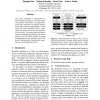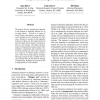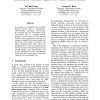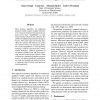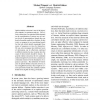111
click to vote
NAACL
2010
14 years 10 months ago
2010
We examine the viability of building large polarity lexicons semi-automatically from the web. We begin by describing a graph propagation framework inspired by previous work on con...
125
click to vote
NAACL
2010
14 years 10 months ago
2010
In this paper, we present an innovative chart mining technique for improving parse coverage based on partial parse outputs from precision grammars. The general approach of mining ...
112
click to vote
NAACL
2010
14 years 10 months ago
2010
Two of the mechanisms for creating natural transitions between adjacent sentences in a text, resulting in local coherence, involve discourse relations and switches of focus of att...
105
click to vote
NAACL
2010
14 years 10 months ago
2010
This paper contributes a formalization of frame-semantic parsing as a structure prediction problem and describes an implemented parser that transforms an English sentence into a f...
141
click to vote
NAACL
2010
14 years 10 months ago
2010
We address the problem of formatting the output of an automatic speech recognition (ASR) system for readability, while preserving wordlevel timing information of the transcript. O...
123
click to vote
NAACL
2010
14 years 10 months ago
2010
We propose the first unsupervised approach to the problem of modeling dialogue acts in an open domain. Trained on a corpus of noisy Twitter conversations, our method discovers dia...
120
click to vote
NAACL
2010
14 years 10 months ago
2010
In this paper we investigate how to identify initiation-response pairs in asynchronous, multi-threaded, multi-party conversations. We formulate the task of identifying initiation-...
109
click to vote
NAACL
2010
14 years 10 months ago
2010
Most learning algorithms for undirected graphical models require complete inference over at least one instance before parameter updates can be made. SampleRank is a rankbased lear...
119
click to vote
NAACL
2010
14 years 10 months ago
2010
Semantic role labeling (SRL) not only needs lexical and syntactic information, but also needs word sense information. However, because of the lack of corpus annotated with both wo...
112
click to vote
NAACL
2010
14 years 10 months ago
2010
Opinion holder extraction is one of the important subtasks in sentiment analysis. The effective detection of an opinion holder depends on the consideration of various cues on vari...

